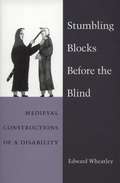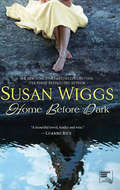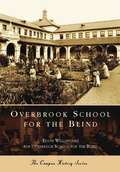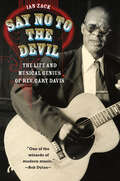Special Collections
Blindness and Visual Impairment Special Collection
Description: A collection featuring biographies, memoirs, fiction and non-fiction by and about members of the blind community. #disability
- Table View
- List View
Stumbling Blocks Before The Blind
by Edward WheatleyStumbling Blocks Before the Blind presents the first comprehensive exploration of a disability in the Middle Ages, drawing on the literature, history, art history, and religious discourse of England and France. It relates current theories of disability to the cultural and institutional constructions of blindness in the eleventh through fifteenth centuries, examining the surprising differences in the treatment of blind people and the responses to blindness in these two countries.
The book shows that pernicious attitudes about blindness were partially offset by innovations and ameliorations---social; literary; and, to an extent, medical---that began to foster a fuller understanding and acceptance of blindness. A number of practices and institutions in France, both positive and negative---blinding as punishment, the foundation of hospices for the blind, and some medical treatment---resulted in not only attitudes that commodified human sight but also inhumane satire against the blind in French literature, both secular and religious. Anglo-Saxon and later medieval England differed markedly in all three of these areas, and the less prominent position of blind people in society resulted in noticeably fewer cruel representations in literature. This book will interest students of literature, history, art history, and religion because it will provide clear contexts for considering any medieval artifact relating to blindness---a literary text, a historical document, a theological treatise, or a work of art.
For some readers, the book will serve as an introduction to the field of disability studies, an area of increasing interest both within and outside of the academy. Edward Wheatley is Surtz Professor of Medieval Literature at Loyola University, Chicago.
Home Before Dark
by Susan WiggsShe left her child behind, but couldn't let her goAs an irresponsible young mother, Jessie Ryder knew she'd never be able to give her newborn the stable family that her older sister could, and the security her child deserved. So Luz and her husband adopted little Lila and told her Jessie was but a distant aunt.Sixteen years later, having traveled the world with the winds of remorse at her back, Jessie is suspending her photojournalism career to return home-even if it means throwing her sister's world into turmoil.Where life once seemed filled with boundless opportunity, Jessie is now on a journey to redeem her careless past, bringing with her a terrible burden. Jessie's arrival is destined to expose the secrets and lies that barely held her daughter's adoptive family together to begin with, yet the truth can do so much more than just hurt. It can bring you home to a new kind of honesty, shedding its light into the deepest corners of the heart.
Overbrook School for the Blind (The Campus History Series)
by Edith WilloughbySince 1832, Overbrook School for the Blind has been a leader in providing educational programs to children and young people who are blind and visually impaired. Julius Friedlander, the schools founder, and other early leaders worked hard to inform people about the educational needs of the children. Their efforts resulted in providing reading material for the blind and Overbrook's production of the first embossed book in America, the Gospel of Mark, and the publication of the first magazine for the blind, Lux en Tenebrae. Offering students access to all educational opportunities continues to be the schools main goal, and in the early 1990s, Overbrook pioneered the development of a school wide technology initiative that provided students with the ability to access the curriculum, communicate, and be successful in employment. Through rare photographs and documents, Overbrook School for the Blind offers a glimpse at the schools role in reaching out to people who are blind and it showcases how Overbrook has helped thousands of students to achieve independence, self-confidence, and the skills to experience active and fulfilling lives.
No Sight - Great Vision
by J. W. WilsonThis text provides a history of the Association for the Blind in Australia.
Say No to the Devil
by Ian ZackWho was the greatest of all American guitarists?
You probably didn't name Gary Davis, but many of his musical contemporaries considered him without peer. Bob Dylan called Davis "one of the wizards of modern music. " Bob Weir of the Grateful Dead--who took lessons with Davis--claimed his musical ability "transcended any common notion of a bluesman. " And the folklorist Alan Lomax called him "one of the really great geniuses of American instrumental music. " But you won't find Davis alongside blues legends Robert Johnson and Muddy Waters in the Rock and Roll Hall of Fame.
Despite almost universal renown among his contemporaries, Davis lives today not so much in his own work but through covers of his songs by Dylan, Jackson Browne, and many others, as well as in the untold number of students whose lives he influenced.
The first biography of Davis, Say No to the Devil restores "the Rev's" remarkable story. Drawing on extensive research and interviews with many of Davis's former students, Ian Zack takes readers through Davis's difficult beginning as the blind son of sharecroppers in the Jim Crow South to his decision to become an ordained Baptist minister and his move to New York in the early 1940s, where he scraped out a living singing and preaching on street corners and in storefront churches in Harlem.
There, he gained entry into a circle of musicians that included, among many others, Lead Belly, Woody Guthrie, and Dave Van Ronk. But in spite of his tremendous musical achievements, Davis never gained broad recognition from an American public that wasn't sure what to make of his trademark blend of gospel, ragtime, street preaching, and the blues. His personal life was also fraught, troubled by struggles with alcohol, women, and deteriorating health.
Zack chronicles this remarkable figure in American music, helping us to understand how he taught and influenced a generation of musicians.




